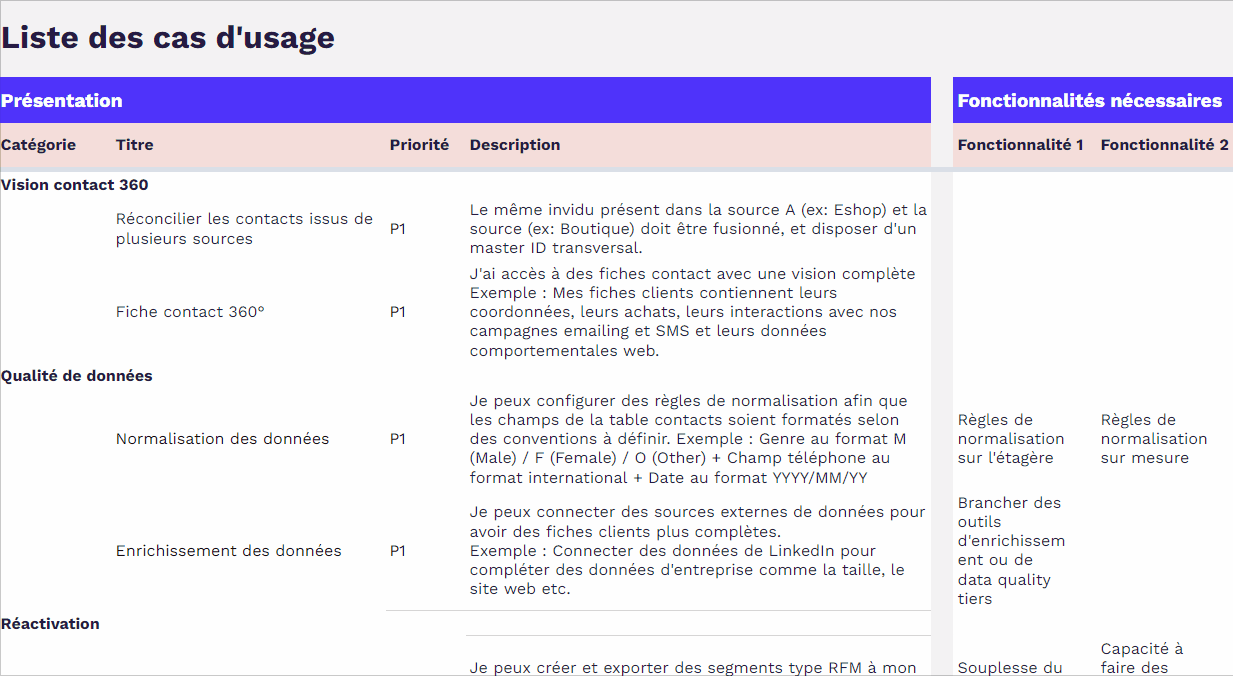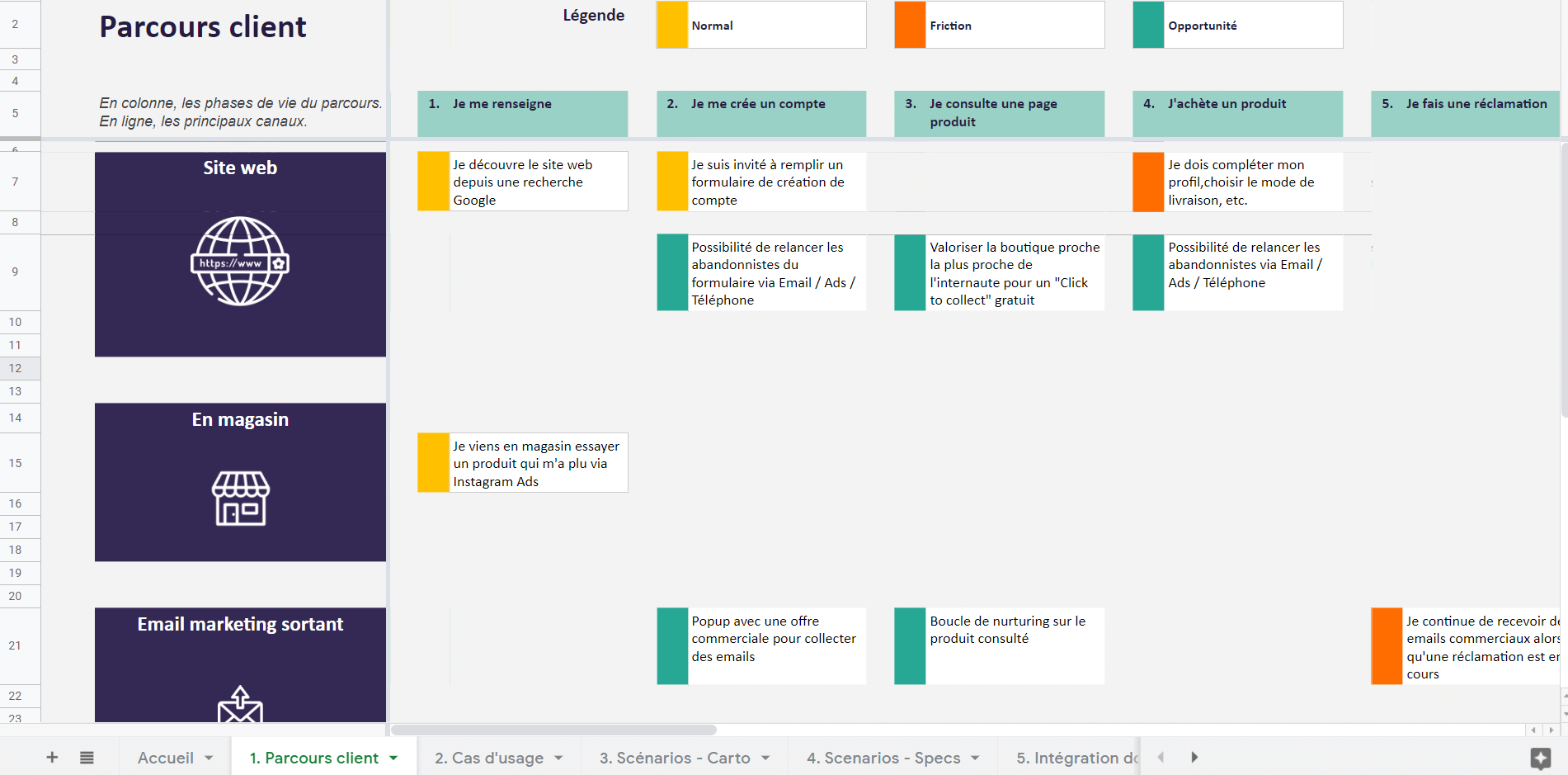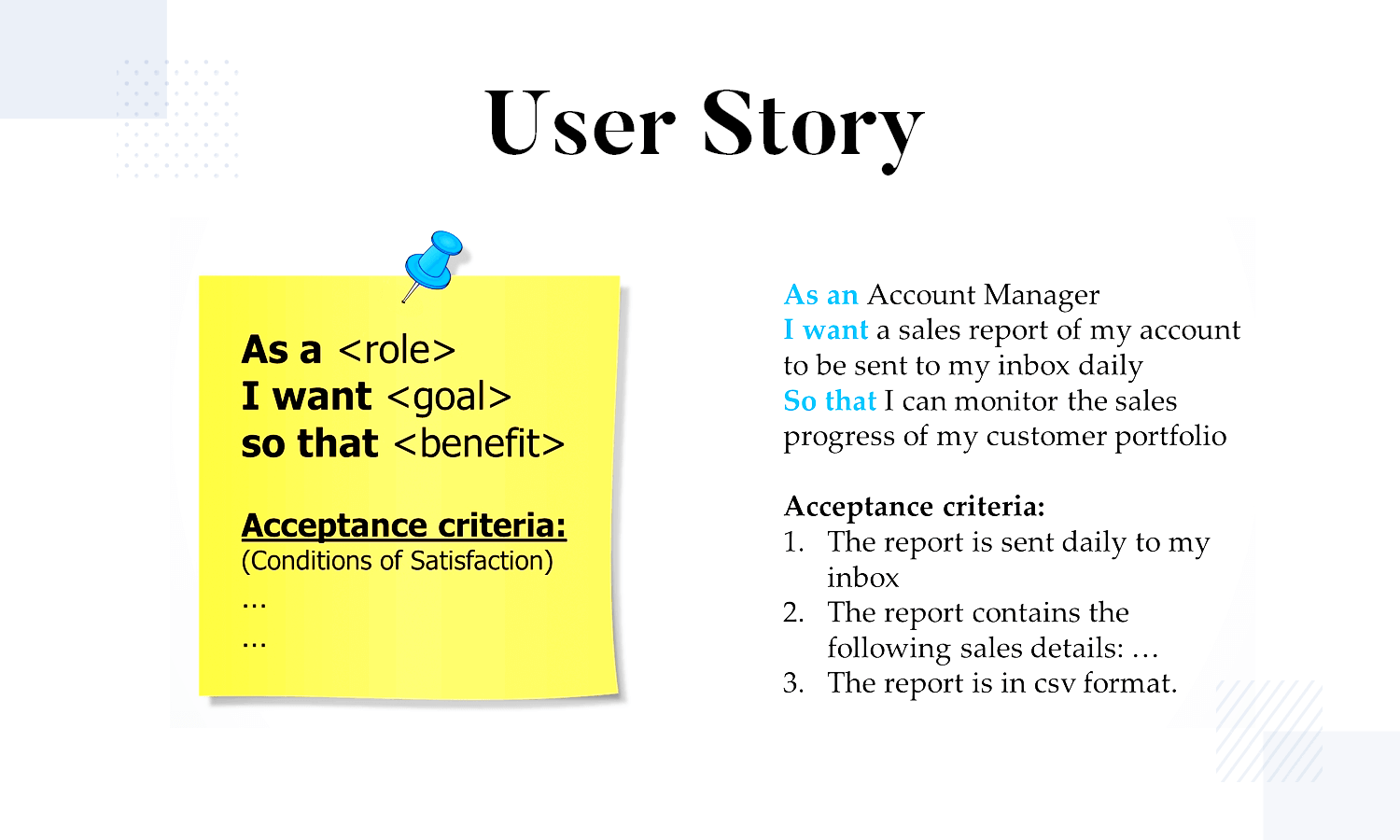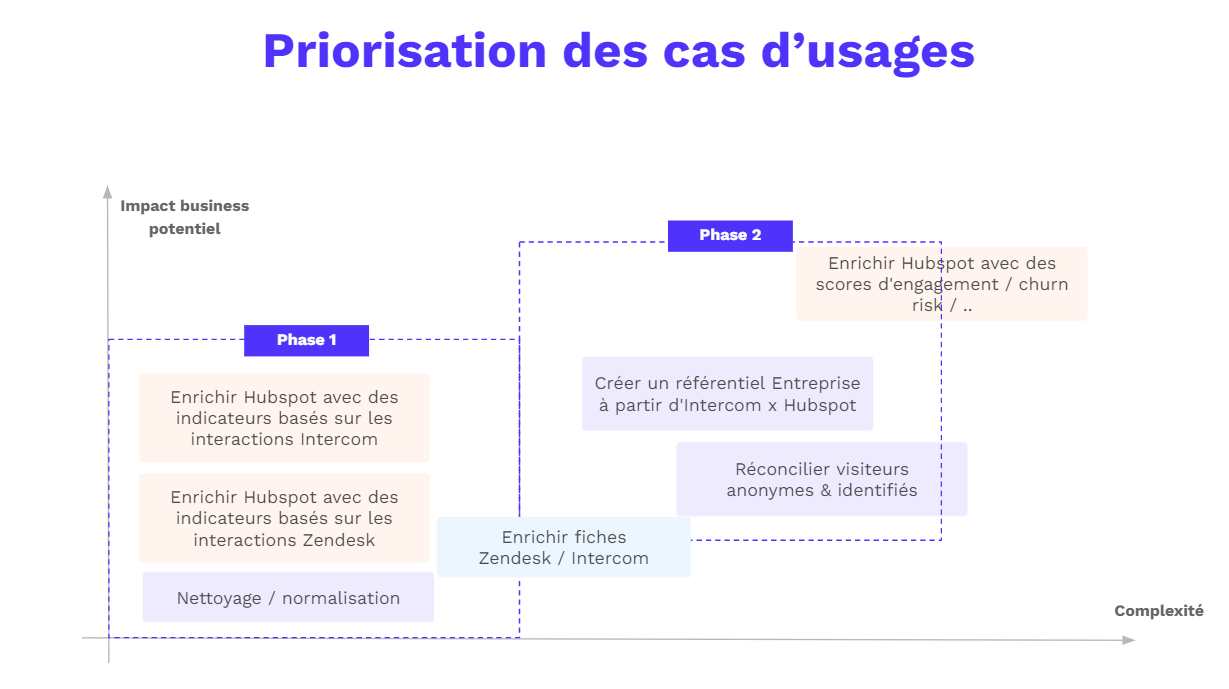In the context of the deployment of your Customer Data Platform, the use cases are the concrete responses that you will provide – via your CDP of course – to the frictions of your business teams identified beforehand.
The challenge of this phase of defining the use cases of your CDP lies of course in your ability to identify them, but also and above all to prioritise them, according to their business impact and their feasibility on a technical level.
In this article, we detail a simple step-by-step process to help you structure the definition of your use cases in a CDP implementation project.
📕 Contents
CDP use cases: the objective
The objective to be achieved when defining your use cases can be summarized in a table like this:
| Category / Objectives | Use cases |
|---|---|
| Data management | Deduplication & 360° customer record |
| Cleaning & standardisation | |
| Adding new sources or destinations via connectors or APIs | |
| Easy modification of the data model | |
| Customised SQL queries & processing | |
| Activation & reactivation | Adding customised segmentation (to personalise a welcome programme according to the persona for example) |
| Scoring & RFM segmentation | |
| Creation of an audience with non-openers and sending to a call centre or Ads platform to follow-up on another channel | |
| Omnichannel | Creating audiences with shop customers who have never bought online, and vice versa |
| Synchronisation of audiences with different tools / channels: CRM, Emailing, Ads, Customer Service, etc. | |
| Upsell / Cross-sell | Add product palatability score |
| Added score better timing for commercial offer | |
| Add promophile score | |
| Synchronisation of scores with CRM tools / Emailing + Website | |
| Reporting & connaissance client | Ability to plug into an existing reporting tool |
| Reportings standards |
Generally, the list of use cases is part of the appendices of the specifications of your CDP implementation project. On the screenshot below, you will find our CDP use case presentation template, available for free download.
Once you have defined and listed your use cases, you will need to prioritise them according to their business impact and their level of complexity.

Find our CDP specifications template for free download
Step #1 First of all, why is it so important to properly define the use cases of a CDP project?
CDP use cases: definition
The concept of use cases was first introduced in the late 1980s by a Swede called Ivar Jacobson. At the time, he was working on telephony systems at Ericsson. His definition of use cases was based on understanding the behaviour of systems.
He presented it to the OOP (Object Oriented Programming) community. Use cases were immediately recognised as filling an important gap in the process of defining the requirements of an IT project. They have since been adopted by project teams, even in so-called agile methods.
As the CDP Institute describes it today, a use case is used to illustrate the capabilities that a CDP platform needs to support a task to achieve certain business objectives. All use cases together present all the useful ways in which a CDP can be used within the organisation.
The definition of use cases, at the heart of your CDP project
The operational value that you will be able to derive from your CDP is directly linked to the use cases that you have defined. They are the key to the tool’s performance, as they enable you to respond to your teams’ business issues.
A use case can address several issues:
- Choosing your CDP from among the various publishers . Indeed, depending on the functionalities required for the implementation of your use cases, certain solutions will be more or less suitable.
- You will start with the use cases defined as priorities in the specifications, in order to prioritise the technical developments.
- Set up your CDP, according to the uses you will make of it.
Once you have clearly identified the different purposes of the use cases in your CDP, you can move on to defining the use cases.
Step #2: Identify target use cases
The definition of your use cases starts with the definition of the objectives targeted by the deployment of your CDP. Having an exhaustive vision of all the possibilities offered by your Customer Data Platform allows you to better structure and prioritise your use cases.
A CDP use case responds to the issues mentioned above, but above all to business objectives. Let’s look at a method for defining them.
List the use cases
There are two main methods for identifying the CDP use cases relevant to your organisation:
The implementation of an omnichannel customer relationship is directly linked to a good understanding of the customer journey! In order to offer a total experience that is harmonised across all channels, you must therefore start by clearly defining the different stages of your customer journey.
To do this, we propose a simple and effective method that will enable you to map your omnichannel customer journey. It is based on a double entry table:

Next, qualify the user experience at each touchpoint. For this, we recommend the following colour code:
We recommend that you carry out this work as a team, as the creation of this map sharpens the imagination of the teams: it is very conducive to creativity!
As part of the deployment of your CDP, the frictions (orange) and opportunities (green) that you identify via this method become your use cases.
This second method consists of working in a collaborative manner by bringing together the CRM teams of course, but also Acquisition, Customer Service, IT, BI, etc., around a workshop to define the use cases. This may seem like a good idea at first, but there are sometimes many stakeholders with different objectives, which can make the process more complex, especially in large organisations.
The use cases should enable you to solve the problems encountered by the business teams in your organisation. Bringing them together is therefore a source of creativity. The ultimate objective is to aim for the most personalised customer experience possible.
Be careful, however, to structure this approach properly beforehand. If you do not sufficiently define the roles and responsibilities of each person beforehand, the value you will get out of it will not meet your expectations. By assigning a clear role to all stakeholders (Responsible, Accountable, Consulted, Informed) the RACI Matrix is a good way of allocating responsibilities when you set out to talk to all the teams that are affected by customer data management in your organisation.
Making the link between use cases and business objectives
Once you have listed all your use cases, categorise them according to the purpose they will serve (they correspond to the categories in our example table at the beginning of the article):
- Data Management: CDP acts as a centralized and unified platform for your customer data from different sources in your company. This data can be internal (back-office, databases, CRM, contact centre, etc.) or external (ecommerce, social networks, etc.).
- Activation & reactivation**: CDP makes customer data actionable. Thanks to the online behaviour of customers, CDP has the capacity to program scenarios adapted to the profile of the target customer, whatever the stage of their purchase journey: from product consultation to payment, including the shopping cart.
- Omnichannel: By offering a 360° view of customer data, CDP aggregates online and offline data in real time. It should therefore enable an omnichannel approach, across several departments in the organisation, to personalise the customer’s physical and digital journey.
- Upsell / Cross-sell: The CDP enables marketing actions to be piloted, thanks to precise and relevant audience segmentation. Marketing teams can then send the right recommendations to the consumer at the right time.
- Reporting & customer knowledge**: A good BI tool is complementary to the implementation of a CDP. It allows you to format the information contained in complex KPIs and databases. Your CDP must communicate with BI for all customer data analysis.
You have identified your target use cases and associated them with the business objectives in which they fit, it is now time to determine the technical challenges that arise from them: mainly in terms of customer data processing.
Determine the challenges in terms of customer data management
To implement the use cases you have imagined, your CDP will, of course, apply different forms of processing to your customer data, including :
- Unifying customer data / RCU plays a key role in many use cases. Data unification allows the identification of all interactions related to a customer or prospect. The purposes are numerous: improvement of data quality, production of the Golden Record or reinforcement of compliance.
- Analyze Make better use of the data generated by your users, particularly when it comes to identifying the performance of the various purchasing paths (see the mapping mentioned above).
- Predict (AI): We are talking about artificial intelligence here, your Customer Data Platform offers intelligent recommendations, based once again on your customers’ behaviour (product recommendations, contact first-time buyers at the best time to generate a second purchase, highlight popular products available in stock, …)
- If necessary, your CDP should allow you to extract customer data from your database in order to reconcile it with other tools (cash register system,…) or for data control.
- Creating precise segments by crossing different data sources in order to send the right message at the right time can improve your conversion rates and increase customer loyalty.
- Orchestrate omnichannel customer relationships: combine data from different sources, online and offline, to create a multi-channel customer experience in real time.
You will find these main processing categories on this mind map proposed by dataem. This work, which consists of associating the use cases with the data processing they involve, is essential for prioritising them from a technical point of view.
Step #3 Formalise the CDP use cases
The formalisation of use cases is a stage that is far too often neglected during CDP deployment projects. Formalisation allows you to go into even more detail in defining your use cases.
Like a User Story in an agile Scrum method, a use case is supposed to illustrate an end need for your users.
A User Story always starts with a functional need coming from the user, which can be raised by different stakeholders. Then, possible solutions are listed through a simple visual design, called Story Mapping. This involves defining the main functional stages of the user journey, then dividing them into User Stories. Finally, a choice is made and some ideas are left out.
To structure a User Story, the most common methodology suggests answering the 3 dimensions “who, what, why”, in this form
- As (end user, administrator or tester, for example):
- I want :
- In order to :

Source : Justinmind
The formalisation of use cases is based on the same approach. In addition, their description must be exhaustive, and contain the following points:
- A Title: often an infinitive phrase, for example “Pushing e-commerce offers or benefits to offline customers”.
- The problem: this is the situation that will be solved with the implementation of the CDP. For example: “our customer records are not integrated with all our external sources, which does not allow for a 360 customer view.
- Benefits: Specify the benefit(s) that the use case will bring to your company. For example, improving the accuracy of segmentations to provide more personalized offers to my customers.
- The solutions: how will the use case meet the above need? For example: I want to connect external databases to have more complete customer records.
- The objectives: you can state the overall purpose or challenge of the use case, for example: Acquisition, Cost optimisation or Activation
- The sector: what activity is concerned by this use case? It could be banking, retail, etc.
- The tools and channels involved: this could be CRM, website, mobile app, social networks, etc.
- The data requested: what types of personal or behavioural data are involved? For example: email, address, telephone, but also web behaviour or interactions with customer service
- The actors involved: there may be departments involved more or less directly in the use case. Define the primary and secondary actors.
- Conditions: Are there any preconditions for the deployment of this use case?
- Sequence descriptions: provide a complete description of the steps of the use case, also called “nominal sequence”, in both normal and alternative cases.
- The cases not covered: if applicable, specify the data or objectives not to be included.
- The different needs: Finally, indicate the needs associated with the use case, which may be technical, legal, business or other aspects.
Step #4 Prioritize your use cases
The method
Now that you have structured the use cases of your CDP, assessed their feasibility and associated them with the objectives to be achieved, you now need to prioritise them.
In our specifications template, we propose a three-level rating: P1, P2, P3. Of course, you are free to define more.
This rating is given according to :
- The business impact of the objective associated with the use case
- The impact on the customer experience, which remains the major objective of the CDP
- The difficulty of implementing the use case, which includes the budget, human and technical resources and development time required.
- The critical issue associated with the project. For example, an objective may not have a very high business impact and may be moderately feasible, but may be absolutely essential to achieve priority cases. For example: unifying data.
An example of prioritisation
The example below is taken from a use case prioritisation exercise carried out with one of our clients. As you will have understood, the objective is to prioritise the use cases with a high business impact and the easiest to implement technically in order to maximise the ROI of your CDP from the start of its implementation. 
In our example, the prioritised use cases (phase 1) are therefore :
- Business use case (yellow). Enriching Hubspot with data linked to the interactions of your customers and prospects from your chat tool (here Intercom). In concrete terms, if a prospect has shown an interest by asking questions via chat, we can increase the marketing pressure via campaigns pushed by Hubspot.
- Business use case (yellow). Enriching Hubspot with data from your support tool: Zendesk. Here, we’re going to bring up customer satisfaction measured by Hubspot to push re-engagement campaigns via Hubspot or make a commercial gesture to dissatisfied customers.
- Data Management use case (purple). Data cleansing and normalisation to work on the cleanest possible customer database from the start.
Download our CDP specification template.
To access the resource, simply register in a few clicks and you will be taken to a quick registration form. Once you have registered, there is a “Resources” tab that will appear in the top menu which will allow you to access all the resources for free download. Hopefully you’ll get a nice surprise, there will be other resources that will be useful 😊


